Spatial Structure Characteristics of Slope Farmland Quality in Plateau Mountain Area: A Case Study of Yunnan Province, China
Abstract
1. Introduction
2. Study area and Data Sources
2.1. Study Area
2.2. Data Sources
3. Methodology
3.1. Quality Evaluation System of Slope Farmland
3.1.1. Evaluation Unit
3.1.2. Construction of Evaluation Index System
3.1.3. Quantification of Evaluation Index
3.1.4. Membership Function
3.1.5. Index Weight
3.1.6. Evaluation Model and Quality Grading
3.2. Research Methods of Spatial Structure Characteristics of SFQ
3.2.1. Geostatistical Analysis Method
3.2.2. Global Spatial Autocorrelation Analysis Method
3.2.3. Local Spatial Autocorrelation Analysis Method
3.2.4. Spatial Cold and Hot Spots Analysis Method
3.3. Data Calculation and Analysis
4. Results and Discussion
4.1. Spatial Distribution Characteristics of SFQ
4.2. Spatial Variation Characteristics of SFQ
4.3. Spatial Autocorrelation Characteristics of SFQ
4.3.1. Global Spatial Autocorrelation Analysis
4.3.2. Local Spatial Autocorrelation Analysis
4.4. Characteristics of Space Cold and Hot Spots in SFQ
5. Conclusions
- (1)
- The SFQ indexes in Yunnan Province distributes between 0.36 and 0.81, with a mean of 0.59 ± 0.06. The SIFIs of most evaluation units are less than 0.6. The spatial distributions of SFQ indexes are significantly different. Moreover, the SFQ grade is based on sixth-class, fifth-class, seventh-class and fourth-class land. The SFQ grade is relatively higher in the Southern Fringe, central Yunnan, Western Yunnan and Southeastern Yunnan, while the SFQ grade is relatively lower in Northeastern Yunnan and Northwestern Yunnan.
- (2)
- The SFQ indexes present a normal spatial distribution, and the Gaussian model can well fit the semi-variance function of SFQ indexes. The Nugget C0 of spatial distribution of SFQ indexes is 0.5293, and the Nugget coefficient C0/(C0+C) is 53.97%. Furthermore, the spatial distribution of SFQ indexes is moderately autocorrelated. The structural factors, such as climatic conditions, soil property, moisture conditions, spatial morphology, etc., play a major role in the spatial heterogeneity of SFQ indexes, but the influence of random factors should not be ignored.
- (3)
- The Moran’s I value of global spatial autocorrelation of SFQ grades is 0.8489. The spatial distribution of SFQ grades has a significant spatial aggregation characteristic. The spatial autocorrelation types of SFQ grades are based on HH aggregation and LL aggregation, as well as the types of their LISA cluster are based on HH aggregation and LL aggregation.
- (4)
- The cold spot and hot spot distributions of SFQ grades display the significantly spatial difference. The hot spot area is mainly distributed in the Central Yunnan and the Southern Fringe, while the cold spot area is mainly distributed in the Northeastern Yunnan, Northwestern Yunnan and Southwestern Yunnan.
Author Contributions
Funding
Acknowledgments
Conflicts of Interest
References
- Foley, J.A.; Ramankutty, N.; Brauman, K.A.; Cassidy, E.S.; Gerber, J.S.; Johnston, M.; Mueller, N.D.; O’Connell, C.; Ray, D.K.; West, P.C. Solutions for a cultivated planet. Nature 2011, 478, 337–342. [Google Scholar] [CrossRef] [PubMed]
- Francis, C.A.; Hansen, T.E.; Fox, A.A.; Hesje, P.J.; Nelson, H.E.; Lawseth, A.E.; English, A. Farmland conversion to non-agricultural uses in the US and Canada: Current impacts and concerns for the future. Int. J. Agric. Sustain. 2012, 10, 8–24. [Google Scholar] [CrossRef]
- Chai, J.; Wang, Z.; Yang, J.; Zhang, L. Analysis for spatial-temporal changes of grain production and farmland resource: Evidence from Hubei Province, central China. J. Clean. Prod. 2019, 207, 474–482. [Google Scholar] [CrossRef]
- Shan, L.; Ann, T.; Yu, W.; Wu, W. Strategies for risk management in urban–rural conflict: Two case studies of land acquisition in urbanising China. Habitat Int. 2017, 59, 90–100. [Google Scholar] [CrossRef] [PubMed]
- Piana, P.; Faccini, F.; Luino, F.; Piliaga, G. Geomorphological landscape research and flood management in a heavily modified Tyrrhenian catchment. Sustainability 2019, 11, 4594. [Google Scholar] [CrossRef]
- Paliaga, G.; Luino, F.; Turconi, L.; Marincioni, F. Exposure to Geo-Hydrological Hazards of the Metropolitan Area of Genoa, Italy: A Multi-Temporal Analysis of the Bisagno Stream. Sustainability 2020, 12, 1114. [Google Scholar] [CrossRef]
- Antrop, M. Landscape change and the urbanization process in Europe. Landsc. Urban Plan 2004, 67, 9–26. [Google Scholar] [CrossRef]
- Rulli, M.C.; Odorico, P.D. Food appropriation through large scale land acquisitions. Environ. Res. Lett. 2014, 9, 064030. [Google Scholar] [CrossRef]
- Song, W.; Pijanowski, B.C.; Tayyebibc, A. Urban expansion and its consumption of high-quality farmland in Beijing, China. Ecol. Indic. 2015, 54, 60–70. [Google Scholar] [CrossRef]
- Zu, J.; Hao, J.M.; Chen, L.; Zhang, Y.B.; Wang, J.; Kang, L.T.; Guo, J.H. Analysis on trinity connotation and approach to protect quantity, quality and ecology of cultivated land. J. China Agric. Univ. 2018, 23, 84–95. [Google Scholar]
- Zhang, J.K.; Zhang, F.R.; Zhang, L.; Zhang, D.; Wu, C.G.; Kong, X.B. Comparison between the potential grain productivity and the actual grain yield of cultivated lands in Mainland China. Sci. Agric. Sin. 2006, 39, 2278–2285. [Google Scholar]
- Zhao, Y.H.; Liu, X.J.; Ao, Y. Analysis of cultivated land change, pressure index and its prediction in Shaanxi province. Trans. Chin. Soc. Agric. Eng. 2013, 29, 217–223. [Google Scholar]
- Shi, D.M.; Jiang, G.Y.; Jiang, P.; Lou, Y.B.; Ding, W.B.; Jin, H.F. Effects of soil erosion factors on cultivated-layer quality of slope farmland in Purple Hilly Area. Trans. Chin. Soc. Agric. Eng. 2017, 33, 270–279. [Google Scholar]
- Fan, F.L.; Xie, D.T.; Wei, C.F.; Ni, J.P.; Yang, J.; Tang, Z.Y.; Zhou, C. Reducing soil erosion and nutrient loss on sloping land under crop-mulberry management system. Environ. Sci. Pollut. Res. 2015, 22, 14067–14077. [Google Scholar] [CrossRef] [PubMed]
- Chen, Z.F.; Shi, D.M.; He, W.; Xia, J.R.; Jin, H.F.; Lou, Y.B. Spatio-temporal distribution and evolution characteristics of slope farmland resources in Yunnan from 1980 to 2015. Trans. Chin. Soc. Agric. Eng. 2019, 35, 256–265. [Google Scholar]
- Power, J.F.; Myers, R.J.K. The maintenance or improvement of farming systems in North America and Australia. In Soil Quality in Semi-Arid Agriculture; Saskatchewan Institute of Pedology: Saskatoon, SK, Canada, 1990; pp. 273–292. [Google Scholar]
- Jiang, G.; Zhang, R.; Ma, W.; Zhou, D.; Wang, X.; He, X. Cultivated land productivity potential improvement in land consolidation schemes in Shenyang, China: Assessment and policy implications. Land Use Policy 2017, 68, 80–88. [Google Scholar] [CrossRef]
- Shen, R.F.; Chen, M.J.; Kong, X.B.; Li, Y.T.; Tong, Y.N.; Wang, J.K.; Li, T.; Lu, M.X. Conception and evalution of quality of arable land and strategies for its management. Acta Pedol. Sin. 2012, 49, 1210–1217. [Google Scholar]
- Wang, L.; Tian, Y.; Yao, X.; Zhu, Y.; Cao, W. Predicting grain yield and protein content in wheat by fusing multi-sensor and multi-temporal remote-sensing images. Field Crops Res. 2014, 164, 178–188. [Google Scholar] [CrossRef]
- Liu, Y.; Zhang, Y.; Guo, L. Towards realistic assessment of cultivated land quality in an ecologically fragile environment: A satellite imagery-based approach. Appl. Geogr. 2010, 30, 271–281. [Google Scholar] [CrossRef]
- Waswa, B.S.; Vlek, P.L.G.; Tamene, L.D.; Okoth, P.; Mbakaya, D.; Zingore, S. Evaluating indicators of land degradation in smallholder farming systems of Western Kenya. Geoderma 2013, 195, 192–200. [Google Scholar] [CrossRef]
- Tan, Y.; Chen, H.; Lian, K.; Yu, Z. Comprehensive Evaluation of Cultivated Land Quality at County Scale: A Case Study of Shengzhou, Zhejiang Province, China. Int. J. Environ. Res. Public Health 2020, 17, 1169. [Google Scholar] [CrossRef] [PubMed]
- Song, W.; Wu, K.; Zhao, H.; Zhao, R.; Li, T. Arrangement of high-standard basic farmland construction based on village-region cultivated land quality uniformity. Chin. Geogr. Sci. 2019, 29, 325–340. [Google Scholar] [CrossRef]
- Xia, Z.; Peng, Y.; Liu, S.; Liu, Z.; Wang, G.; Zhu, A.-X.; Hu, Y. The Optimal Image Date Selection for Evaluating Cultivated Land Quality Based on Gaofen-1 Images. Sensors 2019, 19, 4937. [Google Scholar] [CrossRef]
- Wang, N.; Zu, J.; Li, M.; Zhang, J.; Hao, J. Spatial Zoning of Cultivated Land in Shandong Province Based on the Trinity of Quantity, Quality and Ecology. Sustainability 2020, 12, 1849. [Google Scholar] [CrossRef]
- Steenwerth, K.; Belina, K. Cover crops enhance soil organic matter, carbon dynamics and microbiological function in a vineyard agroecosystem. Appl. Soil Ecol. 2008, 40, 359–369. [Google Scholar] [CrossRef]
- FAO. A Framework for Land Evaluation; ILRI: Nairobi, Kenya, 1976.
- Heilig, G.K.; Fischer, G.; Van, V.H. Can China feed itself? An analysis of China’s food prospects with special reference to water resources. Int. J. Sustain Dev. World Ecol. 2000, 7, 153–172. [Google Scholar] [CrossRef]
- Richard, W.D.; Dennis, R.R. Implementing LESA in Whitman county, Washington. J. Soil Water Conserv. 1983, 38, 87–89. [Google Scholar]
- Qian, F.K.; Wang, Q.B.; Bian, Z.X.; Dong, X.R.; Zheng, L.P. Farmland quality evaluation and site assessment in Lingyuan city. Trans. Chin. Soc. Agric. Eng. 2011, 27, 325–329. [Google Scholar]
- Liu, S.; Peng, Y.; Xia, Z.; Hu, Y.; Wang, G.; Zhu, A.-X.; Liu, Z. The GA-BPNN-Based Evaluation of Cultivated Land Quality in the PSR Framework Using Gaofen-1 Satellite Data. Sensors 2019, 19, 5127. [Google Scholar] [CrossRef]
- Bojorquez-Tapia, L.A.; Diaz-Moadragon, S.; Ezcurra, E. GIS-based approach for participatory decision making and land suitability assessment. Int. J. Geogr. Inf. Sci. 2001, 40, 477–492. [Google Scholar] [CrossRef]
- Kalogirou, S. Expert systems and GIS: An application of land suitability evaluation. Comput. Environ. Urban Syst. 2002, 26, 89–112. [Google Scholar] [CrossRef]
- Wang, Z.; Wang, L.M.; Xu, R.N.; Huang, H.T.; Wu, F. GIS and RS based Assessment of Cultivated Land Quality of Shandong Province. Procedia Environ. Sci. 2012, 12, 823–830. [Google Scholar] [CrossRef]
- Wen, L.Y.; Kong, X.B.; Zhang, B.B.; Sun, X.B.; Xin, Y.N.; Zhang, Q.P. Construction and application of arable land quality evaluation system based on sustainable development demand. Trans. Chin. Soc. Agric. Eng. 2019, 35, 234–242. [Google Scholar]
- Wang, H.; Li, W.; Huang, W.; Nie, K. A Multi-objective permanent basic farmland delineation model based on hybrid particle swarm pptimization. ISPRS Int. J. Geo Inf. 2020, 9, 243. [Google Scholar] [CrossRef]
- Zhao, K.; Rao, Y.; Wang, L.L.; Liu, Y. Evaluation of ecological fragility in southwest of China. J. Geol. Hazards Environ. Preserv. 2004, 15, 38–42. [Google Scholar]
- Chen, Z.F.; Shi, D.M.; He, W.; Xia, J.R.; Jin, H.F.; Lou, Y.B. Temporal and spatial distribution and evolution trend of reference crop evaporation in Yunnan province in recent 60 years. J. Guizhou Norm. Univ. 2018, 36, 83–91. [Google Scholar]
- Liu, Y.W.; Liu, C.W.; He, Z.Y.; Zhou, X. Delineation of basic farmland based on local spatial autocorrelation analysis of cultivated land quality in pixel scale. Trans. Chin. Soc. Agric. Mach. 2019, 50, 260–268. [Google Scholar]
- Chen, Y.Q.; Yang, J.Y.; Yun, W.J.; Zhang, C.; Zhu, D.H.; Xiang, Q.Q. Cultivated land quality grading results integration method at provincial level based on grid. Trans. Chin. Soc. Agric. Eng. 2014, 30, 280–287. [Google Scholar]
- Benjamin, K.; Domon, G.; Bouchard, A. Vegetation composition and succession of abandoned farmland: Effects of ecological, historical and spatial factors. Landsc. Ecol. 2005, 20, 627–647. [Google Scholar] [CrossRef]
- Yao, S.B.; Li, H. Agricultural productivity changes induced by the sloping land conversion program: An analysis of Wuqi County in the Loess Plateau Region. Environ. Manag. 2010, 45, 541–550. [Google Scholar] [CrossRef]
- Martin, Y.; Victor, G.J.; David, G.R. Developing a minimum data set for characterizing soil dynamics in shifting cultivation systems. Soil Tillage Res. 2006, 86, 84–98. [Google Scholar]
- Rezaei, S.A.; Gilkes, R.J.; Andrews, S.S. A minimum data set for assessing soil quality in rangelands. Geoderma 2006, 136, 229–234. [Google Scholar] [CrossRef]
- Cai, H.S.; Lin, J.P.; Zhu, D.H. Cultivated land consolidation planning based on quality evaluation of cultivated land in Poyang Lake region. Trans. Chin. Soc. Agric. Eng. 2007, 23, 75–80. [Google Scholar]
- Li, G.; Wu, C.F.; Cao, S.A. Study on indicators system of selecting cultivated land into prime farmland. J. Agric. Mech. Res. 2006, 8, 46–48. [Google Scholar]
- Bergstrom, D.W.; Monreal, C.M.; Millette, J.A.; King, D.J. Spatial Dependence of Soil Enzyme Activities along a Slope. Soil Sci. Soc. Am. J. 1998, 62, 1302–1308. [Google Scholar] [CrossRef]
- Zhang, Z.; Zhou, Y.; Wang, S.; Huang, X. Spatial distribution of stony desertification and key influencing factors on different sampling scales in small karst watersheds. Int. J. Environ. Res. Public Health 2018, 15, 743. [Google Scholar] [CrossRef] [PubMed]
- Liu, X.L.; Li, W.F.; Yang, L.N.; Xu, W.B. Spatial Variability of Soil Nutrients Based on ArcGIS Geostatistical Analyst A Case Study in Jianshui County of Yunnan Province. Chin. J. Soil Sci. 2012, 43, 1432–1437. [Google Scholar]
- Ma, S.W.; Xie, D.T.; Zhang, X.C.; Peng, Z.T.; Zhu, H.; Hong, H.K.; Xiao, J.J. Spatiotemporal variation in the ecological status of the Three Gorges Reservoir area in Chongqing, China. J. Ecol. 2018, 38, 8512–8525. [Google Scholar]
- Sung, C.H.; Liaw, S.C. A GIS approach to analyzing the spatial pattern of baseline resilience indicators for community (BRIC). Water 2020, 12, 1401. [Google Scholar] [CrossRef]
- Fan, C.; Wang, Z. Spatiotemporal Characterization of Land Cover Impacts on Urban Warming: A Spatial Autocorrelation Approach. Remote Sens. 2020, 12, 1631. [Google Scholar] [CrossRef]
- Malinowski, M.; Smoluk-Sikorska, J. Spatial relations between the standards of living and the financial capacity of Polish district-level local government. Sustainability 2020, 12, 1825. [Google Scholar] [CrossRef]
- Zhang, S.; Zhang, D.D.; Li, J. Climate change and the pattern of the hot spots of war in ancient China. Atmosphere 2020, 11, 378. [Google Scholar] [CrossRef]
- Yang, J.Y.; Du, Z.R.; Du, Z.B.; Huang, J.Y.; Zhao, L.; Zhu, D.H. Well facilitied capital farmland assignment based on land quality evaluation and LISA. Trans. Chin. Soc. Agric. Mach. 2017, 114–120. [Google Scholar] [CrossRef]
- Su, M.; Guo, R.Z.; Hong, W.Y. Institutional transition and implementation path for cultivated land protection in highly urbanized regions: A case study of Shenzhen, China. Land Use Policy 2019, 81, 493–501. [Google Scholar] [CrossRef]
- Chen, Y.J.; Xiao, B.L.; Fang, L.N.; Ma, H.L.; Yang, R.Z.; Yin, X.Y.; Li, Q.Q. The quality analysis of cultivated land in China. Sci. Agric. Sin. 2011, 17, 3557–3564. [Google Scholar]
- Wei, X.D.; Wang, S.N.; Yuan, X.F.; Wang, X.F.; Zhang, B.B. Spatial and temporal changes and its variation of cultivated land quality in Shaanxi Province. Trans. Chin. Soc. Agric. Eng. 2018, 3, 240–248. [Google Scholar]
- Yang, Y.Z.; Li, J.H.; Xiang, D.L.; Yuan, D.; Quan, Y.K.; Zhang, X.F.; Chen, Y.C. Natural grade distribution characteristics of arable land in Yunnan Province. Agric. Eng. 2020, 6, 78–82. [Google Scholar]
- Zeng, W.J.; Zhang, J.S.; Liu, S.X.; Li, C.X.; Ge, X.Y.; Chen, Y.C.; Li, J.H.; Yu, X.J. Research on the Spatial distribution characteristics of arable land natural quality grade of watersheds in Yunnan Province. Int. Res. Water Soil Conserv. 2016, 23, 267–273. [Google Scholar]
- Wei, S.C.; Xiong, C.S.; Luan, Q.L.; Hu, Y.M. Protection zoning of arable land quality index based on local spatial autocorrelation. Trans. Chin. Soc. Agric. Eng. 2014, 30, 249–256. [Google Scholar]
- Li, W.Y.; Zhu, C.M.; Wang, H.; Xu, B.G. Multi-scale spatial autocorrelation analysis of cultivated land quality in Zhejiang province. Trans. Chin. Soc. Agric. Eng. 2016, 32, 239–245. [Google Scholar]
- Xiong, C.S.; Tan, R.; Yue, W.Z. Zoning of high standard farmland construction based on local indicators of spatial association. Trans. Chin. Soc. Agric. Eng. 2015, 31, 276–284. [Google Scholar]
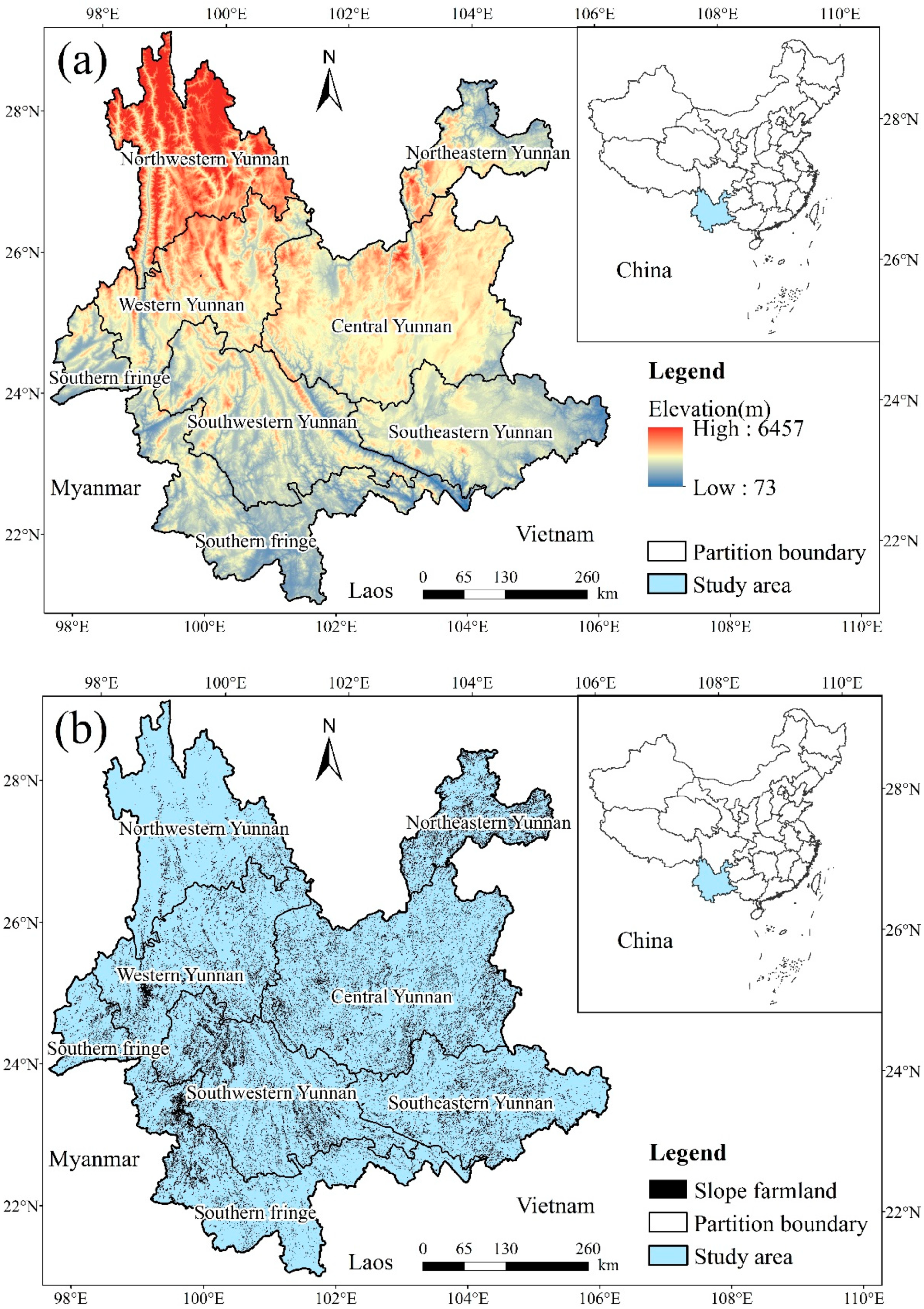
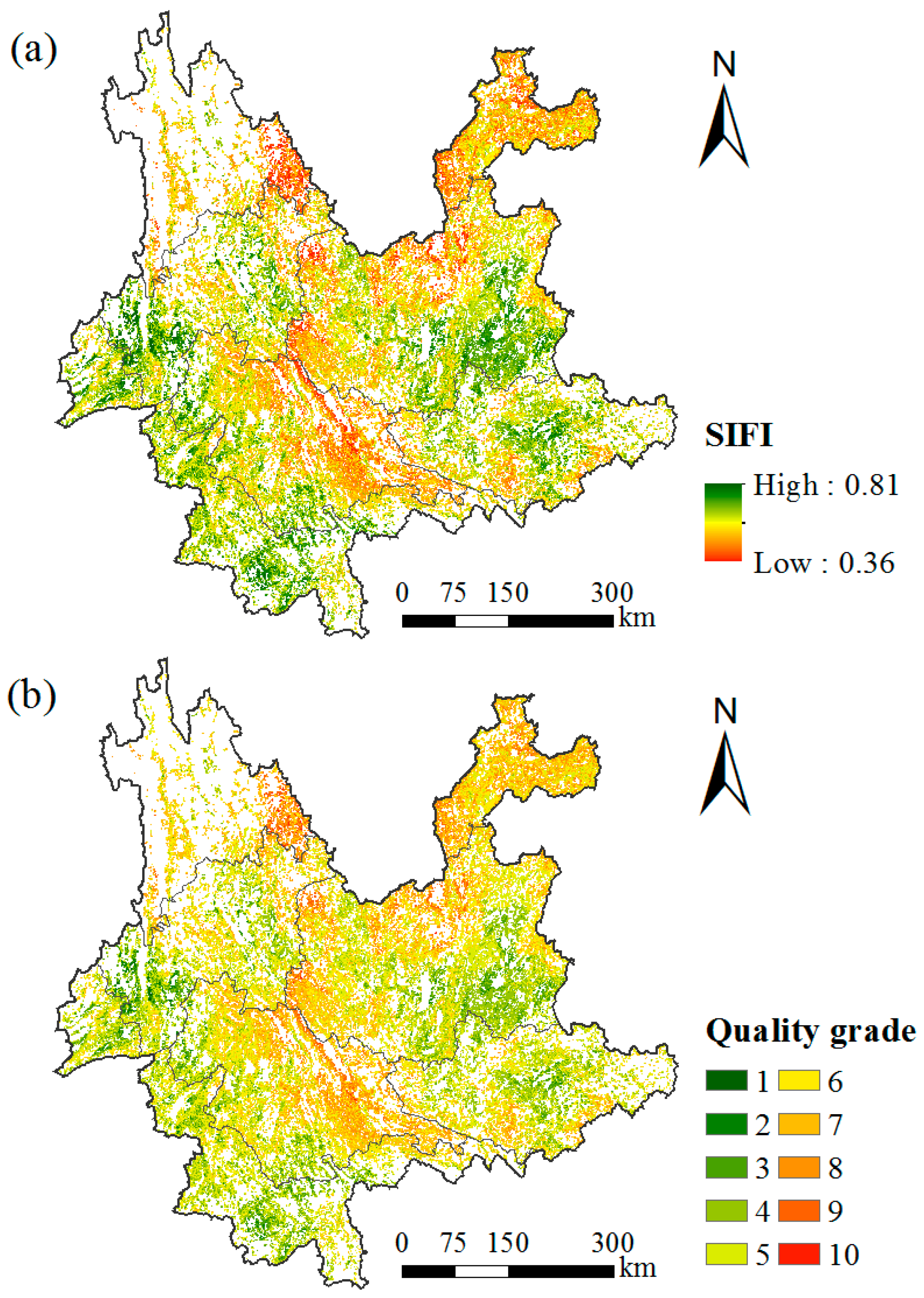
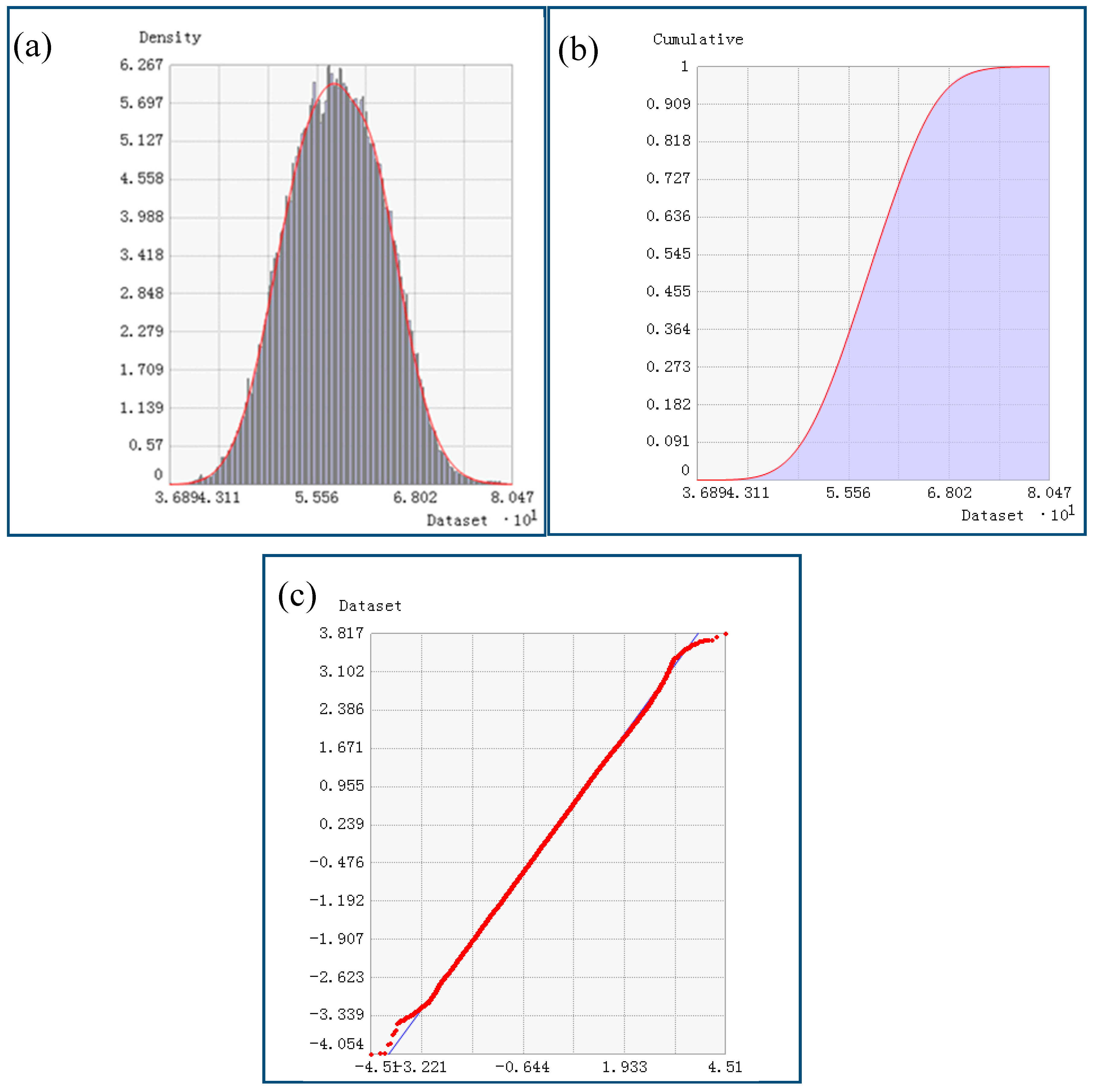
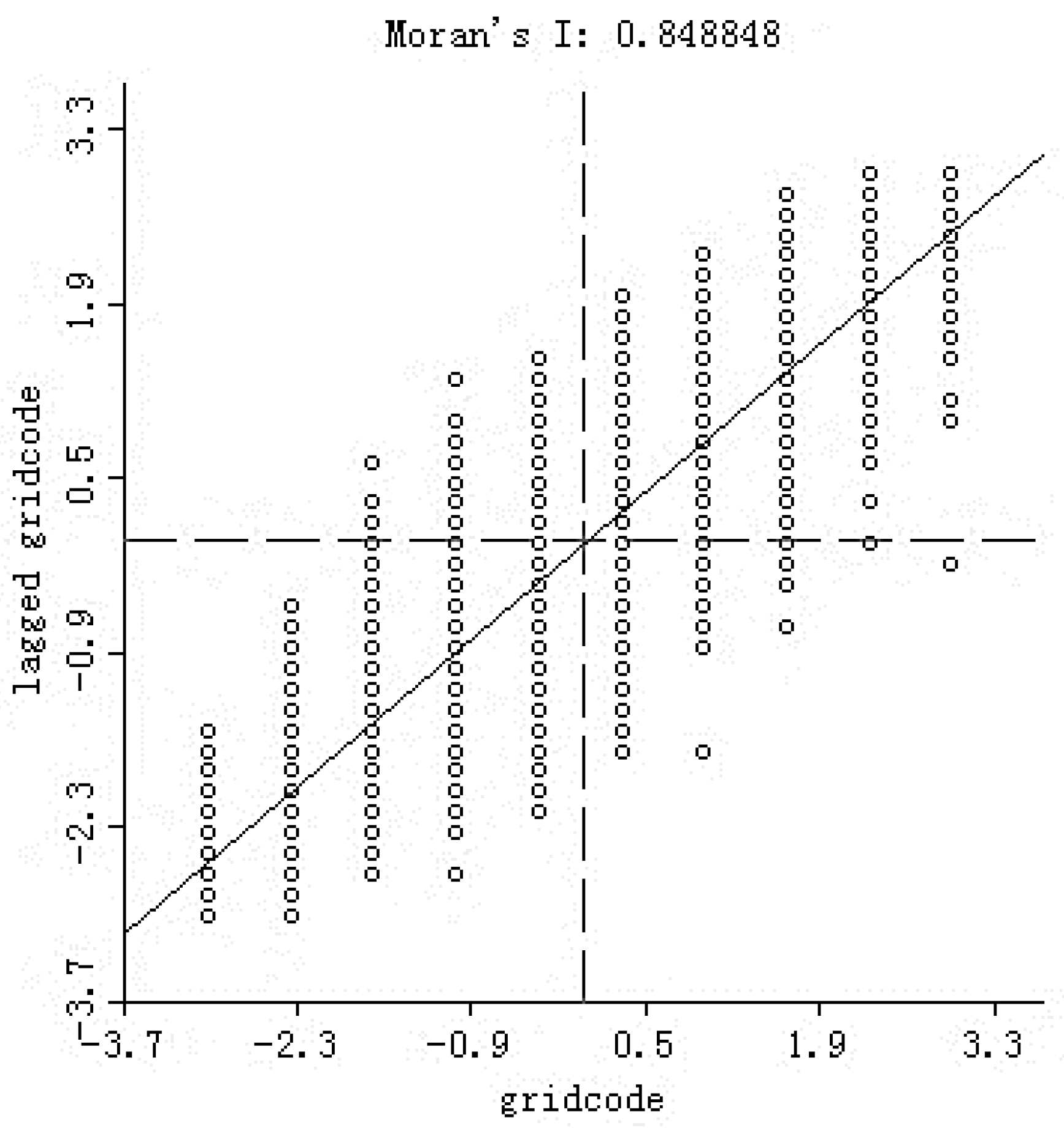
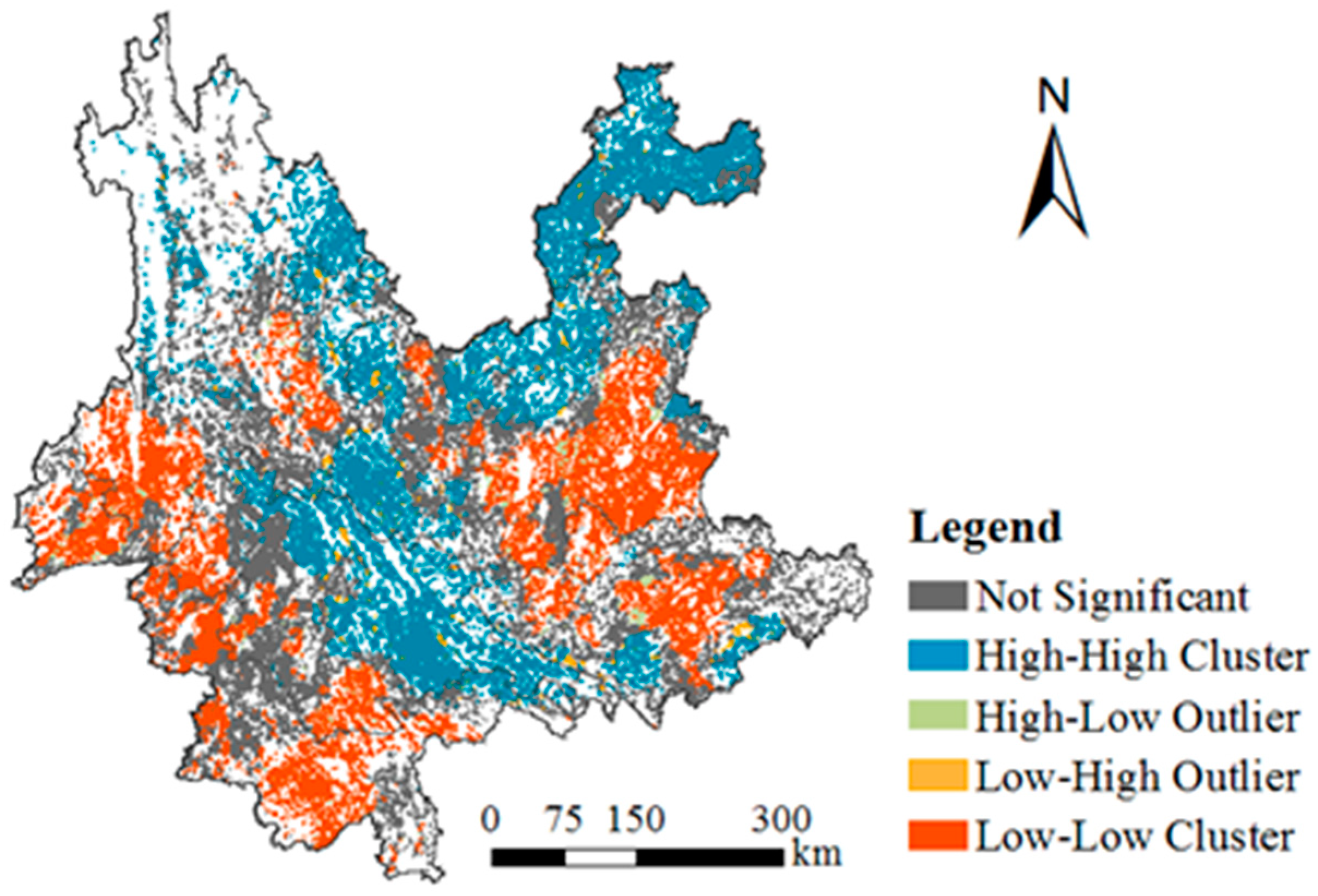
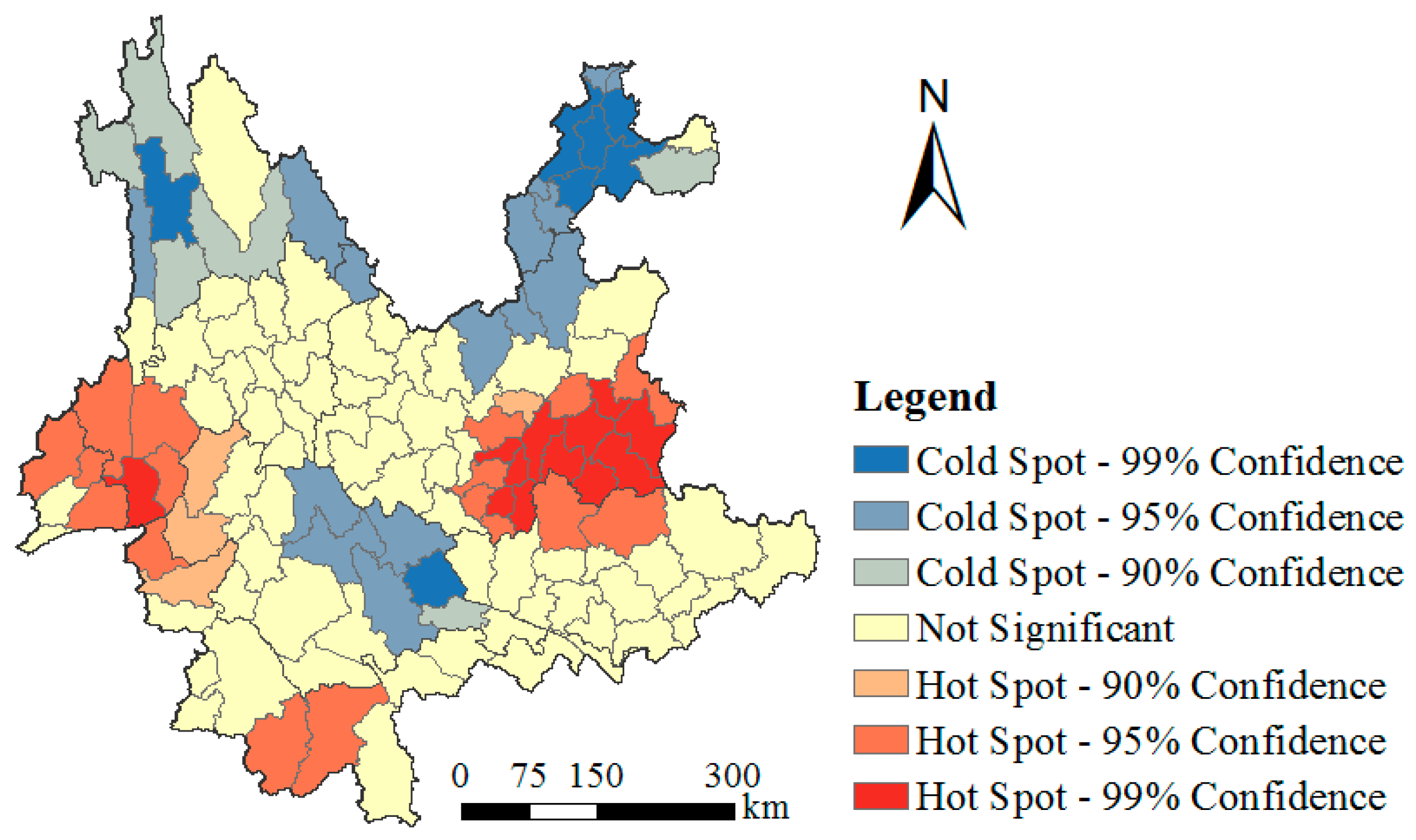
| Partition Name | Arable Land | Dry Land | Slope Farmland | ||||||
|---|---|---|---|---|---|---|---|---|---|
| Area (×104hm2) | Proportion of Land Area | Average Slope (°) | Area (×104hm2) | Average slope (°) | Proportion of Cultivated Land Area | Area (×104hm2) | Average Slope (°) | Proportion of Cultivated Land Area | |
| Central Yunnan | 187.76 | 21.32% | 9.70 | 132.16 | 11.69 | 70.39% | 114.80 | 13.20 | 61.14% |
| Western Yunnan | 91.94 | 18.13% | 12.28 | 62.71 | 15.02 | 68.21% | 58.10 | 16.09 | 63.20% |
| Southeastern Yunnan | 95.73 | 19.02% | 10.90 | 67.06 | 11.97 | 70.05% | 58.55 | 13.46 | 61.16% |
| Southwestern Yunnan | 109.20 | 18.46% | 16.31 | 96.15 | 17.00 | 88.05% | 93.60 | 17.41 | 85.71% |
| Southern Fringe | 99.03 | 15.90% | 12.61 | 77.89 | 14.39 | 78.66% | 71.32 | 15.58 | 72.03% |
| Northeastern Yunnan | 62.95 | 27.61% | 16.08 | 55.68 | 16.45 | 88.46% | 52.80 | 17.25 | 83.88% |
| Northwestern Yunnan | 30.40 | 5.95% | 18.01 | 25.74 | 19.14 | 84.66% | 23.34 | 20.97 | 76.77% |
| Total | 676.99 | 17.61% | 12.68 | 517.39 | 14.41 | 76.42% | 472.55 | 15.62 | 69.79% |
| Target Layer (A) | Criterion Level (B) | Index Level (C) | ||
|---|---|---|---|---|
| Code | Classification | Code | Index | |
| Slope farmland quality (A) | B1 | Soil profile properties | C1 | Effective soil layer thickness (cm) |
| C2 | Thickness of cultivated-layer (cm) | |||
| B2 | Physicochemical properties | C3 | Bulk density (g/cm3) | |
| C4 | Soil texture (Dimensionless) | |||
| C5 | pH value (Dimensionless) | |||
| C6 | Organic matter (g/kg) | |||
| B3 | soil nutrient | C7 | Available phosphorus (mg/kg) | |
| C8 | Available potassium (mg/kg) | |||
| B4 | Site conditions | C9 | ≥10 °C accumulated temperature (°C) | |
| B5 | Spatial form | C10 | Field regularity (Dimensionless) | |
| C11 | Degree of continuity (Dimensionless) | |||
| B6 | Moisture condition | C12 | Rainfall (mm) | |
| C13 | Irrigation assurance rate (%) | |||
| B7 | Soil erosion | C14 | Slope (°) | |
| Index Code | Index | Membership Function Type | Formula of Membership Function | Parameters | |
|---|---|---|---|---|---|
| a | b | ||||
| C1 | Effective soil layer | S-type | 30.0 | 120.0 | |
| C2 | Thickness of cultivated-layer | S-type | 14.03 | 20.00 | |
| C6 | Organic matter | S-type | 15.0 | 40.0 | |
| C7 | Available phosphorus | S-type | 5.70 | 53.83 | |
| C8 | Available potassium | S-type | 40.00 | 216.06 | |
| C9 | ≥10 °C accumulated temperature | S-type | 3000.0 | 5500.0 | |
| C11 | Degree of continuity | S-type | 20.0 | 100.0 | |
| C12 | Rainfall | S-type | 800.0 | 1200.00 | |
| C13 | Irrigation assurance rate | S-type | 40.0 | 100.0 | |
| C3 | Soil bulk density | Anti-S-type | 1.15 | 1.50 | |
| C10 | Field regularity | Anti-S-type | 1.00 | 1.34 | |
| C14 | Slope | Anti-S-type | 3.00 | 25.00 | |
| Index Code | Index | Membership Function Type | Formula of Membership Function | Parameters | |||
|---|---|---|---|---|---|---|---|
| a1 | b1 | b2 | a2 | ||||
| C5 | pH value | Parabolic-type (Peak type) | 5.5 | 6.5 | 7.5 | 8.5 | |
| Quality Grade | Area Proportion of Different Zones (%) | Total | |||||||
|---|---|---|---|---|---|---|---|---|---|
| Central Yunnan | Western Yunnan | Southeastern Yunnan | Southwestern Yunnan | Southern Fringe | Northeastern Yunnan | Northwestern Yunnan | Area (×104hm2) | Proportion (%) | |
| 1 | 0.00 | 0.72 | 0.00 | 0.00 | 0.00 | 0.00 | 0.00 | 0.45 | 0.09 |
| 2 | 0.18 | 3.74 | 0.01 | 0.11 | 0.60 | 0.00 | 0.00 | 3.07 | 0.65 |
| 3 | 5.05 | 11.98 | 4.74 | 2.59 | 8.78 | 0.00 | 0.03 | 24.77 | 5.24 |
| 4 | 19.34 | 27.06 | 22.86 | 9.18 | 25.41 | 0.09 | 2.00 | 79.75 | 16.88 |
| 5 | 23.35 | 24.88 | 36.03 | 20.16 | 46.01 | 1.97 | 7.96 | 118.01 | 24.97 |
| 6 | 26.82 | 21.76 | 27.96 | 28.83 | 16.67 | 29.49 | 33.72 | 121.63 | 25.74 |
| 7 | 17.22 | 8.47 | 6.76 | 25.46 | 2.42 | 50.64 | 28.39 | 85.94 | 18.19 |
| 8 | 6.49 | 1.33 | 1.61 | 12.35 | 0.10 | 16.13 | 19.17 | 33.06 | 7.00 |
| 9 | 1.49 | 0.08 | 0.03 | 1.30 | 0.00 | 1.68 | 7.90 | 5.61 | 1.19 |
| 10 | 0.06 | 0.00 | 0.00 | 0.02 | 0.00 | 0.00 | 0.83 | 0.27 | 0.06 |
| Theoretical Model | Error Prediction Parameters | ||||
|---|---|---|---|---|---|
| Mean | Mean Square Root | Standardized Mean | Root-Mean-Square Standardized | Mean Standard Error | |
| Circular model | −0.000158 | 0.0362 | −0.00323 | 0.7959 | 0.0455 |
| Spherical model | −0.000151 | 0.0362 | −0.00308 | 0.7953 | 0.0456 |
| Exponential model | −0.000105 | 0.036 | −0.0021 | 0.7889 | 0.0457 |
| Gaussian model | −0.000219 | 0.0364 | −0.00452 | 0.8038 | 0.0454 |
| Inspection Parameters | Central Yunnan | Western Yunnan | Southeastern Yunnan | Southwestern Yunnan | Southern Fringe | Northeastern Yunnan | Northwestern Yunnan |
|---|---|---|---|---|---|---|---|
| Moran’s I | 0.8684 | 0.8440 | 0.9364 | 0.8263 | 0.8847 | 0.6293 | 0.8279 |
| Z-score | 307.13 | 187.77 | 234.60 | 243.20 | 306.89 | 80.79 | 168.25 |
| p-value | 0.0000 | 0.0000 | 0.0000 | 0.0000 | 0.0000 | 0.0000 | 0.0000 |
© 2020 by the authors. Licensee MDPI, Basel, Switzerland. This article is an open access article distributed under the terms and conditions of the Creative Commons Attribution (CC BY) license (http://creativecommons.org/licenses/by/4.0/).
Share and Cite
Chen, Z.; Shi, D. Spatial Structure Characteristics of Slope Farmland Quality in Plateau Mountain Area: A Case Study of Yunnan Province, China. Sustainability 2020, 12, 7230. https://doi.org/10.3390/su12177230
Chen Z, Shi D. Spatial Structure Characteristics of Slope Farmland Quality in Plateau Mountain Area: A Case Study of Yunnan Province, China. Sustainability. 2020; 12(17):7230. https://doi.org/10.3390/su12177230
Chicago/Turabian StyleChen, Zhengfa, and Dongmei Shi. 2020. "Spatial Structure Characteristics of Slope Farmland Quality in Plateau Mountain Area: A Case Study of Yunnan Province, China" Sustainability 12, no. 17: 7230. https://doi.org/10.3390/su12177230
APA StyleChen, Z., & Shi, D. (2020). Spatial Structure Characteristics of Slope Farmland Quality in Plateau Mountain Area: A Case Study of Yunnan Province, China. Sustainability, 12(17), 7230. https://doi.org/10.3390/su12177230





